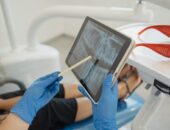Dental treatments are often associated with pain and discomfort. But with the help of laser dentistry, it is now possible to make dental treatments more comfortable and less painful. Laser dentistry is a relatively new technology that uses lasers to perform various dental procedures. It has revolutionized how dentists treat their patients, allowing them to provide pain-free treatments without the need for anesthesia.
Read on to learn more.
How Does Laser Dentistry Work?
Laser dentistry works by using a small but powerful beam of light. The intensity of this light produces a numbing effect, reducing the need for anesthesia. Laser dentistry is non-invasive and ensures only the problem area is addressed, leaving the rest of the mouth untouched.
For instance, soft tissue dental laser treatments, such as gum reshaping, crown lengthening, and the removal of lesions, are all performed using a laser. It does not require any scalpels or drills, making it less invasive than traditional methods. This means that you experience less pain and have faster recovery times.
Benefits of Laser Dentistry for Dental Procedures
Here are some advantages of laser dentistry to dental procedures:
- Precision. Laser dentistry is incredibly precise and can target specific areas with pinpoint accuracy. This makes it less invasive, and there is less damage to the surrounding tissues, leading to less pain and a quicker recovery time.
- Reduced bleeding and swelling. Laser dentistry is gentle on tissues, so you experience less bleeding and swelling during and after treatment. This makes laser treatments suitable for those with bleeding disorders and individuals on blood-thinning medications.
- Pain-free. Laser dentistry produces a numbing effect that eliminates the need for anesthesia, making the treatment process a pain-free and comfortable experience for patients.
- Faster recovery times. Laser dentistry treatments offer quicker recovery times than traditional methods. The laser beam stimulates cell growth and promotes healing, leading to a faster recovery time than traditional dental procedures.
- Reduced risk of infection. Laser treatments can reduce the risk of infection among dental patients. The high-intensity laser beam sterilizes the surrounding area of each tooth, including the root canal, which results in a lower risk of infection.
- Versatile. Laser dentistry is versatile and can treat several dental conditions. It can be used to fix cavities, treat gum disease, perform oral surgery, and even teeth whitening. Children can also benefit from laser dentistry as a safe and effective treatment option.
Note that while laser dentistry offers several benefits, it’s still important to choose a dentist with experience in this technology. They should be certified and can explain all the risks and advantages associated with the procedure. See this great dentist in New York for more details on how laser dentistry works.
Conclusion
Laser dentistry is a revolutionary technology, which makes dental treatments more comfortable and less painful. It is non-invasive, precise, and gentle on the tissues, allowing for fast recovery times and reduced risk of infection. That’s why laser dentistry is becoming increasingly popular among dentists as an effective way to treat various dental conditions without patients feeling anxious and uncomfortable. If you are considering laser dentistry, talk to a certified dentist with the necessary experience to provide quality treatment.




